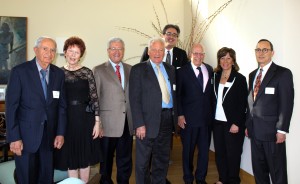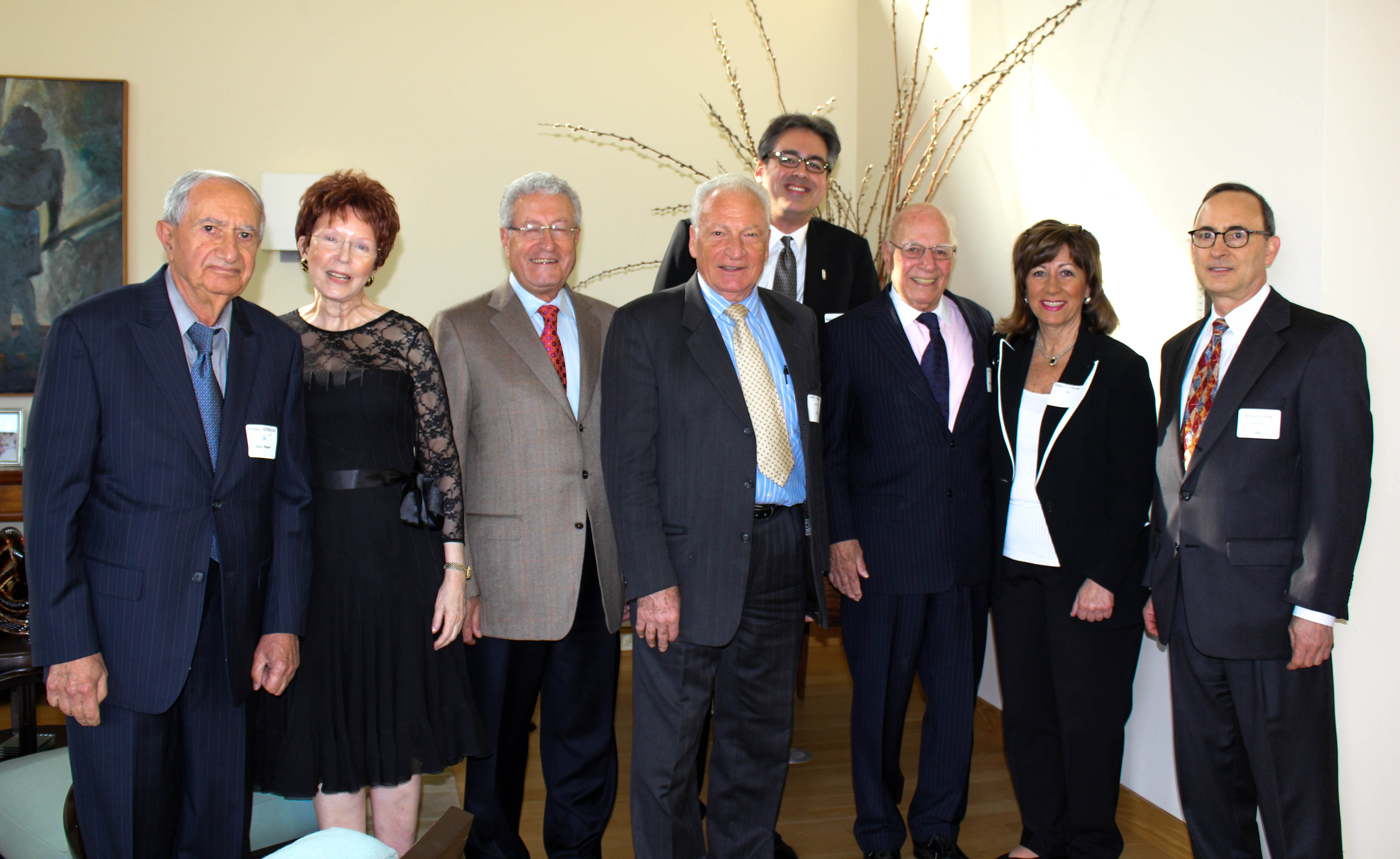
Left to right: Dr. Gregory Ketabgian*, Anne E. Elbrecht*, Yervant Chekijian*, Raffi P. Yeghiayan*, Marc A. Mamigonian, Paul R. Ignatius, Nancy R. Kolligian*, Bruce W. Roat* (*NAASR Board Member)
The event’s Master of Ceremonies was Paul Ignatius – an active 93-year-old and former US Navy Secretary who is likely the first Armenian-American born in Glendale.
The evening was organized by Southern California NAASR Board members Bruce Roat and Dr. Gregory Ketabgian, and featured a dialogue between documentary filmmaker Dr. Carla Garapedian and writer/scholar Professor Peter Balakian.
“Fifty-five years ago my father got the bug for NAASR to help them set up endowed chairs at Harvard and UCLA in Armenian studies,” said Ignatius, who served as Assistant Secretary of Defense and Secretary of the Navy during the Kennedy and Johnson presidential administrations. His father, Hovsep, an immigrant from Kharpert, was involved in many Armenian causes including efforts at the inception of NAASR to keep Armenian history alive for future generations. Ignatius emphasized that NAASR continues to be a uniquely important organization that needs to be supported by all who value scholarship and increased knowledge about Armenian subjects.
Garapedian and Balakian engaged in a half-hour-long discussion on the topic of “Scholarship and the Pursuit of Justice,” specifically the fraudulent academic apparatus supported by the Turkish government to further their project of denial of the Armenian Genocide. Balakian spoke of the need to counter this campaign both through scholarship and through the kind of informed activism that scholarship makes possible. He pointed to the example of the exposure and shaming of Princeton’s Heath Lowry by Robert Jay Lifton in the 1990s, when it was found that Lowry was working closely with the Turkish Embassy in Washington, D.C., as a key moment in demonstrating the relationship between academia and the Turkish state. The publicity surrounding this affair had brought the denial issue out in the open in the mid-1990s.
Although—or perhaps because—the Armenian Genocide today receives far greater coverage in scholarly work, on television, and in social media than in previous decades, denial persists. The discussion turned to Turkey’s attempt to pressure the Rwanda Genocide Museum to remove materials on the Armenian Genocide.
A last hour effort by genocide scholars and writers, including Balakian, who had gathered there to give a symposium helped to block that effort.
Similarly, in 2005 there was a Turkish-supported attempt in England to have the Parliament officially repudiate the authenticity and validity of the Bryce/Toynbee “Blue Book” (aka The Treatment of Armenians in the Ottoman Empire 1915-1916). This effort ultimately failed and led to noted British human rights lawyer Geoffrey Robertson writing a report entitled “Was There an Armenian Genocide?” which was highly critical of Turkish-led denial and British acquiescence. Revisionist historiography by Turkish and Azeri scholars has picked up speed and needs a large number of trained scholars to answer their claims. Garapedian and Balakian stressed the need for financial support of institutions such as NAASR to enable increased grants to deserving researchers and scholars, and the importance of continued “cultural production” in various media and forums in order keep Armenian history and culture alive and moving forward.
As Peter Balakian stated at the conclusion: “We need to move into a much higher level of professionalism, it needs to involve creative thinking and needs to be proactive. It should be emerging as we walk out tonight.”
NAASR Board’s Executive Committee updated the audience on the present status and future goals of the organization. Marc Mamigonian, NAASR Director of Academic Affairs, took special note of NAASR’s renewed high level of activity in Southern California, thanks to the efforts of current Board members Roat and Ketabgian, as well as former Board member Dr. Rubina Peroomian. He also pointed to the close working relationship with the Ararat-Eskijian Museum in Mission Hills, whose director Maggie Mangassarian-Goschin serves on NAASR’s Southern California committee.
Next, he detailed some of the tasks that NAASR performs at the present, including organizing and collaborating on lectures and other public programs; providing research/publication grants; maintaining an extensive library; functioning as a communication hub for scholars; assisting researchers; distributing books on Armenian subjects; publishing; and organizing heritage trips to Historic Armenia led by prominent scholars. As did Garapedian and Balakian, he emphasized that it is crucial that NAASR substantially increase its capacity to provide grants and support for scholars and vital projects.
He was followed by Yervant Chekijian, who explained the establishment of the Leadership Circle as an upper level of annual support which will allow NAASR to expand upon the work it currently performs. Chekijian emphasized the importance of members of the community showing leadership by taking responsibility for the strengthening of institutions such as NAASR that support scholarship and preserve Armenian history and culture.
For further information about NAASR, its Leadership Circle, or its programs for the advancement of Armenian Studies, contact: NAASR Headquarters at 617-489-1610 or hq@naasr.org.

